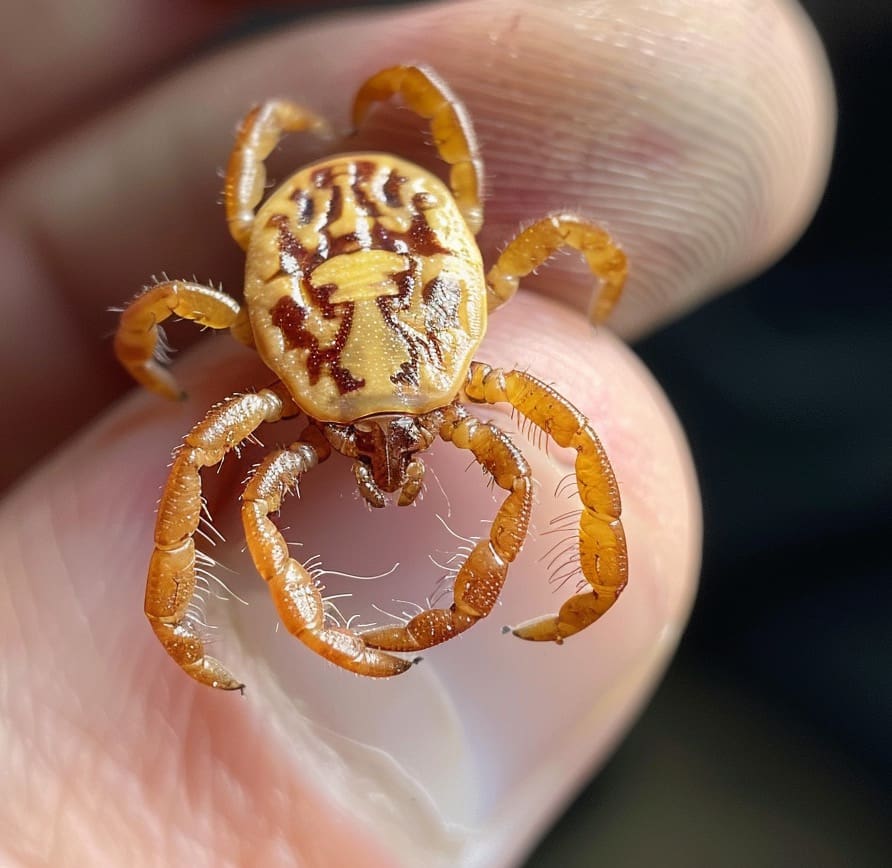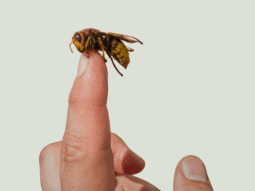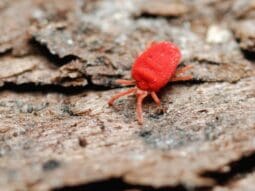
We've all heard of tick bites causing Lyme disease, but did you know that some ticks can trigger a bizarre food allergy? Enter the lone star tick, a tiny arachnid that's causing big problems across the United States.
This unassuming creature has been linked to a surprising and potentially dangerous condition: an allergy to red meat. As cases of this peculiar allergy rise, more people are wondering about the connection between the lone star tick and their sudden inability to enjoy a juicy steak.
In this article, we'll explore the fascinating world of the lone star tick and its impact on human health. We'll delve into how these ticks can cause allergies, the symptoms to watch out for, and what you can do to protect yourself from this unexpected culinary consequence.
What Is the Lone Star Tick?
The lone star tick (Amblyomma americanum) is a species of tick native to the United States. It's known for its distinctive appearance and potential to cause a rare red meat allergy in humans.
Identification and Habitat
The lone star tick is easily identifiable by the white dot or "lone star" on the back of adult females. Adult males have white markings along the edge of their bodies. These ticks measure about 1/8 to 1/4 inch in length and have a reddish-brown color.
Lone star ticks thrive in wooded areas with dense underbrush and tall grass. They're commonly found in:
- Southeastern and South-central United States
- Eastern seaboard, from Texas to Iowa
- As far north as Maine
These ticks are expanding their range due to climate change, increasing their presence in northern and western regions of the U.S.
Understanding Alpha-Gal Syndrome
Alpha-gal syndrome is a unique allergic condition triggered by lone star tick bites. This unusual allergy causes immune system reactions to a specific sugar molecule found in red meat and other mammalian products.
The Link Between Lone Star Ticks and Alpha-Gal
Lone star ticks transmit alpha-gal molecules through their saliva during a bite. When these ticks feed on humans, they introduce alpha-gal into the bloodstream, prompting the immune system to produce antibodies. This sensitization process leads to allergic reactions when individuals later consume red meat or other products containing alpha-gal.
The connection between lone star ticks and alpha-gal syndrome was first discovered in 2009. Since then, researchers have identified a clear correlation between tick bite exposure and the development of this allergy. Areas with high lone star tick populations, such as the southeastern United States, report higher incidences of alpha-gal syndrome.
Studies show that up to 20% of individuals bitten by lone star ticks develop alpha-gal antibodies. However, not all who develop antibodies experience allergic reactions. The exact mechanisms determining who becomes allergic remain under investigation.
Symptoms of Alpha-Gal Syndrome
Alpha-gal syndrome presents a unique set of symptoms that can vary in severity and onset. Understanding these symptoms is crucial for proper diagnosis and management of the condition.
Delayed Onset of Symptoms
Alpha-gal syndrome's hallmark is its delayed allergic reaction. Symptoms typically appear 3-6 hours after consuming red meat or other mammalian products. This delay often makes it challenging for individuals to connect their symptoms with food consumption. Unlike immediate food allergies, alpha-gal reactions don't occur within minutes of exposure, leading to potential misdiagnosis or confusion about the cause. The time lag between eating and symptom onset is due to the slow digestion of alpha-gal molecules in mammalian fat.
Diagnosing Alpha-Gal Syndrome
Symptoms and Clinical Presentation
Alpha-gal syndrome presents unique diagnostic challenges due to its delayed onset and varied symptoms. Key indicators include:
- Hives or itchy rash
- Nausea or stomach cramps
- Difficulty breathing
- Dizziness or fainting
- Swelling of lips, throat, tongue, or eyelids
These symptoms typically occur 3-6 hours after consuming mammalian products, distinguishing alpha-gal syndrome from immediate-onset food allergies.
Diagnostic Tests
Confirming alpha-gal syndrome involves specific diagnostic procedures:
- Blood tests: Measure alpha-gal specific IgE antibodies
- Skin prick tests: Assess immediate allergic reactions to mammalian products
- Oral food challenges: Conducted under medical supervision to observe delayed reactions
Medical History and Tick Exposure
A thorough medical history is crucial for diagnosis, including:
- Recent tick bites or outdoor activities in tick-prone areas
- Timing of symptoms in relation to food consumption
- Types of foods that trigger reactions
Physicians in tick-endemic regions are increasingly aware of alpha-gal syndrome, improving diagnostic accuracy.
Differential Diagnosis
Alpha-gal syndrome must be differentiated from other conditions:
- Other food allergies
- Celiac disease
- Histamine intolerance
- Gastrointestinal disorders
The delayed onset and specific trigger foods help distinguish alpha-gal syndrome from these conditions.
Challenges in Diagnosis
Diagnosing alpha-gal syndrome can be complex due to:
- Delayed reaction time
- Variability in symptom severity
- Potential confusion with other allergies or intolerances
- Limited awareness among healthcare providers in non-endemic areas
Early recognition and proper testing are essential for accurate diagnosis and effective management of alpha-gal syndrome.
Treatment and Management
Managing alpha-gal syndrome primarily involves avoiding triggers and being prepared for potential reactions. We'll explore the necessary dietary modifications and emergency preparedness measures for individuals with this condition.
Dietary Modifications
Alpha-gal syndrome requires strict avoidance of mammalian meat and products. This includes:
- Beef, pork, lamb, venison, and other red meats
- Organ meats from mammals
- Dairy products (in some cases)
- Gelatin and other animal-derived ingredients
Safe alternatives include:
- Poultry (chicken, turkey)
- Fish and seafood
- Plant-based protein sources
Careful label reading is essential, as alpha-gal can be present in unexpected products like medications or cosmetics. Consulting with a registered dietitian ensures a balanced, alpha-gal-free diet.
Emergency Preparedness
Individuals with alpha-gal syndrome must be prepared for potential allergic reactions:
- Carry an epinephrine auto-injector at all times
- Wear a medical alert bracelet or necklace
- Create an emergency action plan with specific steps to follow during a reaction
- Educate family, friends, and coworkers about the condition and how to assist in an emergency
Regular follow-ups with an allergist help monitor the condition and adjust management strategies as needed. Some individuals may see a decrease in sensitivity over time, but ongoing vigilance is crucial for safety.
Prevention Strategies
Preventing lone star tick bites is crucial for avoiding alpha-gal syndrome and other tick-borne illnesses. We'll explore effective tick avoidance techniques and proper tick removal methods to minimize the risk of exposure.
Tick Avoidance Techniques
Tick avoidance is the first line of defense against alpha-gal syndrome. When venturing outdoors in tick-prone areas:
- Wear long-sleeved shirts and long pants, tucking pants into socks
- Apply EPA-registered insect repellents containing DEET, picaridin, or IR3535
- Treat clothing and gear with permethrin, an insecticide effective against ticks
- Stay on designated trails and avoid walking through tall grass or dense vegetation
- Conduct thorough tick checks after outdoor activities, paying close attention to hidden areas like armpits, groin, and scalp
- Shower within two hours of coming indoors to wash off unattached ticks
Proper Tick Removal
If a tick is found attached to the skin, prompt and correct removal is essential:
- Use fine-tipped tweezers to grasp the tick as close to the skin's surface as possible
- Pull upward with steady, even pressure to remove the tick
- Avoid twisting or jerking, which can cause the tick's mouthparts to break off and remain in the skin
- Clean the bite area and your hands with rubbing alcohol, iodine scrub, or soap and water
- Dispose of the tick by submersing it in alcohol, sealing it in a bag, or flushing it down the toilet
- Never crush a tick with your fingers
After removal, monitor the bite site for signs of infection or rash. If symptoms develop, consult a healthcare provider immediately.
Long-Term Outlook for Alpha-Gal Syndrome
Alpha-gal syndrome's long-term prognosis varies among individuals. Many patients experience a gradual decrease in sensitivity over time, with some achieving complete resolution of symptoms. However, this process often takes years and requires strict adherence to dietary restrictions.
Studies show that 20% of alpha-gal syndrome patients report symptom improvement within 1-2 years, while 45% see improvements after 3-5 years. The remaining 35% continue to experience symptoms for extended periods. Factors influencing recovery include:
- Avoiding additional tick bites
- Adhering to dietary restrictions
- Individual immune system responses
Regular monitoring of alpha-gal antibody levels helps track progress. A decrease in antibody levels often correlates with reduced allergic reactions. Patients work closely with allergists to assess their condition and adjust management strategies accordingly.
Research into potential treatments for alpha-gal syndrome is ongoing. Current areas of investigation include:
- Immunotherapy approaches
- Targeted medications to block allergic responses
- Genetic factors influencing susceptibility and recovery
While a cure remains elusive, advancements in understanding and managing alpha-gal syndrome continue to improve patients' quality of life and long-term outcomes.
Romex Pest Control Tick Solutions
At Romex Pest Control, we offer comprehensive tick control solutions to protect you and your family from the risks associated with lone star ticks and other tick species. Our expert technicians use advanced techniques and environmentally friendly products to effectively reduce tick populations on your property.
Integrated Tick Management
Our integrated tick management approach combines multiple strategies for optimal results:
- Property inspection to identify tick-prone areas
- Targeted treatments for tick habitats
- Landscaping recommendations to reduce tick-friendly environments
- Ongoing monitoring and follow-up treatments as needed
Eco-Friendly Tick Control Products
We utilize EPA-approved, low-impact pesticides that are:
- Effective against ticks in various life stages
- Safe for humans, pets, and beneficial insects when used as directed
- Designed to break down quickly in the environment
Tick Prevention Education
Our services include educating homeowners on tick prevention measures:
- Proper lawn maintenance techniques
- Creating tick-safe zones around outdoor living areas
- Personal protection strategies during outdoor activities
Customized Treatment Plans
We develop tailored tick control plans based on:
- Property size and landscape features
- Tick species present in your area
- Specific risk factors for your family and pets
Professional Application
Our certified technicians ensure precise and effective treatment application:
- Strategic placement of products in high-risk areas
- Proper dosage and timing for maximum efficacy
- Regular reassessment and adjustment of treatment strategies
By choosing Romex Pest Control for tick management, you're taking a proactive step in protecting your family from tick-borne illnesses, including alpha-gal syndrome. Our comprehensive approach addresses current tick populations while helping prevent future infestations, providing you with peace of mind and a safer outdoor environment.
In Summary
The lone star tick presents a unique threat to our health through alpha-gal syndrome. Understanding this condition and taking preventive measures are crucial for protecting ourselves and our loved ones. At Romex Pest Control we're committed to helping you safeguard your property against ticks and other pests. Our comprehensive approach combines expert knowledge cutting-edge treatments and personalized solutions. By partnering with us you're not just controlling pests you're investing in your family's health and peace of mind. Don't let ticks dictate your outdoor activities - take action today and reclaim your space with confidence.
We hope you enjoy these informational articles. If you'd like to learn more about our eco-friendly pest control services, call (844) 955-2447.
Read More
Your Path to a Pest-Free Home or Business
Romex Pest Control
We are committed to protecting you, your children, and your pets with our eco-friendly, child-friendly, and pet-friendly guaranteed pest control solutions.
Romex Pest Control is fully insured and licensed in Texas, Oklahoma, Louisiana, and Mississippi.
Service Areas:
Hours
M-F 8 am–5 pm
Sat 8 am–2 pm
Sun Closed
Established 2016 © Copyright 2025 Romex Pest Control










